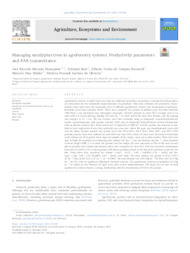Managing eucalyptus trees in agroforestry systems: productivity parameters and PAR transmittance.
Managing eucalyptus trees in agroforestry systems: productivity parameters and PAR transmittance.
Author(s): PEZZOPANE, J. R. M.; BOSI, C.; BERNARDI, A. C. de C.; MULLER, M. D.; OLIVEIRA, P. P. A.
Summary: Agroforestry systems, in which trees and crops are cultivated in rotation, succession, or association with pastures, are alternatives for the sustainable implementation of agriculture. This study estimated the productive characteristics from eight years old eucalyptus trees in different agroforestry systems and transmission of photosynthetically active solar radiation (PAR). These were composed of a pasture of palisade grass (Urochloa brizantha 'BRS Piatã') and eucalyptus trees (Eucalyptus urograndis 'GG100') planted in April 2011 in single rows 15 m apart with 2 m in-row spacing, totaling 333 trees ha-1. In 2016, half of the trees were thinned, and the spacing was changed to 15 × 4 m. The two systems were then evaluated using an integrated crop-livestock-forestry system (agrosilvopasture with pasture renewal, ICLF) and an integrated livestock-forest system (silvopasture with no pasture renewal, ILF). Each system had 12 paddocks of 5000 m2. In ICLF, pasture was renewed in onethird of each replication of area (two paddocks) per crop year, where the grass was simultaneously sown with corn for silage. Pasture renewal was carried out in the 2013-2014, 2014-2015, 2016-2017, and 2017-2018 growing seasons. Data were collected in April 2016 and June 2019, when 110 trees were harvested to determine wood volume and 28 to gather wood rings and samples of the canopy, roots, and carbon content. These data were used to build the equations for estimating stem volume (m3 tree 1) and tree biomass (kg tree - 1). Stem diameter at breast height (DBH, 1.3 m above the ground) and tree height (H) were measured in 10% of the trees in each plot to estimate stem volume and biomass; these were compared by t-test (5%). PAR was measured continuously from 2013 to 2019 at 70 cm aboveground with linear quantum sensors at the four ICLF positions across the tree line. Using these data, equations for volume = exp[(-10.21 + 1.68 × ln(DBH)+1.29 × ln(H)] and biomass = exp[- 3.88 + 2.41*ln(DBH)+0.62 × ln(H)] were built. The stem volume was greater in ICLF (225.7 m3 ha 1) than in ILF (215.2 m3 ha- 1) (p = 0.0369). The total biomass was 148.3 Mg ha 1 for ICLF and 141.0 Mg ha-1 for ILF, with no significant differences between systems. The agroforestry systems accumulated 64.5 Mg ha 1 of carbon in tree biomass by eight years after system implementation. The basal area of trees in both agroforestry systems showed a strong relationship with the transmission of PAR to the pasture.
Publication year: 2021
Types of publication: Journal article
Keywords: Basal area, Biomass, Biomassa, Carbon, Eucalipto, ILPF, Sistema ILPF, Sistema agroflorestal, Stem volume, Árvore Florestal
Observation
Some of Embrapa's publications are published as ePub files. To read them, use or download one of the following free software options to your computer or mobile device. Android: Google Play Books; IOS: iBooks; Windows and Linux: Calibre.
Access other publications
Access the Agricultural Research Database (BDPA) to consult Embrapa's full library collection and records.
Visit Embrapa Bookstore to purchase books and other publications sold by Embrapa.

